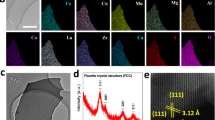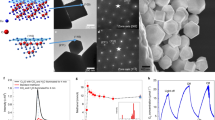Abstract
Cuprous oxide (Cu2O), an earth-abundant, low-cost metal-oxide semiconductor, has received enormous attention for its CO2 reduction ability in aqueous media by photochemical, photoelectrochemical and electrochemical methods. An unresolved problem with all of these approaches, however, is the instability of the Cu2O caused by its tendency to undergo an irreversible redox disproportionation reaction. Here, we report a way to circumvent this troublesome behaviour of Cu2O by driving the CO2 reduction in the gas-phase via heterogeneous photocatalytic hydrogenation. To this end, Cu2O nanocubes with surfaces comprising mixed oxidation-state copper Cu(0,I,II) sites, oxygen vacancies [O] and hydroxyl OH groups were synthesized. These surfaces enable heterolysis of H2 and adsorption of CO2 under mild conditions; they facilitate the reverse water–gas shift reaction, while rendering the redox disproportionation reaction reversible. This synergism provides Cu2O nanocubes with high photocatalytic activity and stability.
This is a preview of subscription content, access via your institution
Access options
Access Nature and 54 other Nature Portfolio journals
Get Nature+, our best-value online-access subscription
$29.99 / 30 days
cancel any time
Subscribe to this journal
Receive 12 digital issues and online access to articles
$119.00 per year
only $9.92 per issue
Buy this article
- Purchase on Springer Link
- Instant access to full article PDF
Prices may be subject to local taxes which are calculated during checkout






Similar content being viewed by others
Data availability
The data that support the plots within this paper and other findings of this study are available from the corresponding author upon reasonable request.
References
IPCC. Climate Change 2013: The Physical Science Basis: Working Group I Contribution to the Fifth Assessment Report of the Intergovernmental Panel on Climate Change (eds Stocker, T. F. et al.) (Cambridge Univ. Press, 2013).
Schreier, M. et al. Covalent immobilization of a molecular catalyst on Cu2O photocathodes for CO2 reduction. J. Am. Chem. Soc. 138, 1938–1946 (2016).
Tu, W., Zhou, Y. & Zou, Z. Photocatalytic conversion of CO2 into renewable hydrocarbon fuels: state‐of‐the‐art accomplishment, challenges, and prospects. Adv. Mater. 26, 4607–4626 (2014).
Roy, S. C., Varghese, O. K., Paulose, M. & Grimes, C. A. Toward solar fuels: photocatalytic conversion of carbon dioxide to hydrocarbons. ACS Nano 4, 1259–1278 (2010).
Wang, J. C. et al. Enhanced photoreduction CO2 activity over direct Z-scheme α-Fe2O3/Cu2O heterostructures under visible light irradiation. ACS Appl. Mater. Interfaces 7, 8631–8639 (2015).
Li, H., Zhang, X. & MacFarlane, D. R. Carbon quantum dots/Cu2O heterostructures for solar‐light‐driven conversion of CO2 to methanol. Adv. Energy Mater. 5, 1401077 (2015).
Handoko, A. D. & Tang, J. Controllable proton and CO2 photoreduction over Cu2O with various morphologies. Int. J. Hydrog. Energy 38, 13017–13022 (2013).
Grace, A. N. et al. Electrochemical reduction of carbon dioxide at low overpotential on a polyaniline/Cu2O nanocomposite based electrode. Appl. Energy 120, 85–94 (2014).
Chang, X. et al. Tuning Cu/Cu2O interfaces for the reduction of carbon dioxide to methanol in acqueous solutions. Angew. Chem. Int. Ed. 57, 15415–15419 (2018).
Tran, P. D., Wong, L. H., Barber, J. & Loo, J. S. Recent advances in hybrid photocatalysts for solar fuel production. Energy Environ. Sci. 5, 5902–5918 (2012).
Ghadimkhani, G., de Tacconi, N. R., Chanmanee, W., Janaky, C. & Rajeshwar, K. K. Efficient solar photoelectrosynthesis of methanol from carbon dioxide using hybrid CuO–Cu2O semiconductor nanorod arrays. Chem. Commun. 49, 1297–1299 (2013).
Xu, H. et al. Porous-structured Cu2O/TiO2 nanojunction material toward efficient CO2 photoreduction. Nanotechnol 25, 165402 (2014).
Li, F. et al. Photocatalytic CO2 conversion to methanol by Cu2O/graphene/TNA heterostructure catalyst in a visible-light-driven dual-chamber reactor. Nano Energy 27, 320–329 (2016).
Gou, L. & Murphy, C. J. Solution-phase synthesis of Cu2O nanocubes. Nano Lett. 3, 231–234 (2003).
Kuo, C. H., Chen, C. H. & Huang, M. H. Seed‐mediated synthesis of monodispersed Cu2O nanocubes with five different size ranges from 40 to 420 nm. Adv. Funct. Mater. 17, 3773–3780 (2007).
Park, J. C., Kim, J., Kwon, H. & Song, H. Gram‐scale synthesis of Cu2O nanocubes and subsequent oxidation to CuO hollow nanostructures for lithium‐ion battery anode materials. Adv. Mater. 21, 803–807 (2009).
Tsai, Y. H., Chanda, K., Chu, Y. T., Chiu, C. Y. & Huang, M. H. Direct formation of small Cu2O nanocubes, octahedra, and octapods for efficient synthesis of triazoles. Nanoscale 6, 8704–8870 (2014).
Huang, W. C., Lyu, L. M., Yang, Y. C. & Huang, M. H. Synthesis of Cu2O nanocrystals from cubic to rhombic dodecahedral structures and their comparative photocatalytic activity. J. Am. Chem. Soc. 134, 1261–1267 (2011).
Liu, H. et al. Scalable synthesis of hollow Cu2O nanocubes with unique optical properties via a simple hydrolysis-based approach. J. Mater. Chem. A. 1, 302–307 (2013).
Strandberg, H. Reactions of copper patina compounds—II. Influence of sodium chloride in the presence of some air pollutants. Atmos. Environ. 32, 3521–3526 (1998).
Lin, H. & Frankel, G. Atmospheric corrosion of Cu by UV, ozone and NaCl. Corros. Eng. Sci. Technol. 48, 461–468 (2013).
Sun, S., Yang, Q., Liang, S. & Yang, Z. Hollow CuxO (x = 2, 1) micro/nanostructures: synthesis, fundamental properties and applications. CrystEngComm 19, 6225–6251 (2017).
Liu, X. D., Hagihala, M., Zheng, X. G. & Guo, Q. X. Vibrational spectroscopic properties of botallackite-structure basic copper halides. Vib. Spectrosc. 56, 177–183 (2011).
Wang, Y. et al. Synthesis of porous Cu2O/CuO cages using Cu-based metal–organic frameworks as templates and their gas-sensing properties. J. Mater. Chem. A. 3, 12796–12803 (2015).
Colin, S., Beche, E., Berjoan, R., Jolibois, H. & Chambaudet, A. An XPS and AES study of the free corrosion of Cu-, Ni-and Zn-based alloys in synthetic sweat. Corros. Sci. 41, 1051–1065 (1999).
Jiang, P. et al. Experimental and theoretical investigation of the electronic structure of Cu2O and CuO thin films on Cu (110) using x-ray photoelectron and absorption spectroscopy. J. Chem. Phys. 138, 024704 (2013).
Azimi, H. et al. Effective ligand passivation of Cu2O nanoparticles through solid-state treatment with mercaptopropionic acid. J. Am. Chem. Soc. 136, 7233–7236 (2014).
Kattel, S., Yan, B., Yang, Y., Chen, J. G. & Liu, P. Optimizing binding energies of key intermediates for CO2 hydrogenation to methanol over oxide-supported copper. J. Am. Chem. Soc. 138, 12440–12450 (2016).
Toledo-Antonio, J. A. et al. Low-temperature FTIR study of CO adsorption on titania nanotubes. J. Phys. Chem. C. 111, 10799–10805 (2007).
Zecchina, A., Scarano, D., Bordiga, S., Spoto, G. & Lamberti, C. Surface structures of oxides and halides and their relationships to catalytic properties. Adv. Catal. 46, 265–397 (2001).
Liu, L., Gao, F., Zhao, H. & Li, Y. Tailoring Cu valence and oxygen vacancy in Cu/TiO2 catalysts for enhanced CO2 photoreduction efficiency. Appl. Catal. B. 134, 349–358 (2013).
Liu, L. et al. Engineering coexposed {001} and {101} facets in oxygen-deficient TiO2 nanocrystals for enhanced CO2 photoreduction under visible light. ACS Catal. 6, 1097–1108 (2016).
Korzhavyi, P. A., Soroka, I. L., Isaev, E. I., Lilja, C. & Johansson, B. Exploring monovalent copper compounds with oxygen and hydrogen. Proc. Natl Acad. Sci. USA 109, 686–689 (2012).
Bennett, E. et al. How the surface structure determines the properties of CuH. Inorg. Chem. 54, 2213–2220 (2015).
Sun, B. Z., Chen, W. K., Zheng, J. D. & Lu, C. H. Roles of oxygen vacancy in the adsorption properties of CO and NO on Cu2O (1 1 1) surface: results of a first-principles study. Appl. Surf. Sci. 255, 3141–3148 (2008).
Hara, M. et al. Cu2O as a photocatalyst for overall water splitting under visible light irradiation. Chem. Commun. 3, 357–358 (1998).
Acknowledgements
Q.Z. wishes to thank NSFC (grant no. 21677080) for the partial support of this study. G.A.O. acknowledges the financial support of the following agencies: Ontario Ministry of Research and Innovation; Ministry of Economic Development, Employment and Infrastructure; Ministry of the Environment and Climate Change; Best in Science; Ministry of Research Innovation and Science Low Carbon Innovation Fund; Ontario Centre of Excellence Solutions 2030 Challenge Fund; Alexander von Humboldt Foundation; Imperial Oil; University of Toronto Connaught Innovation Fund; Connaught Global Challenge Fund and the Natural Sciences and Engineering Research Council of Canada. L.Wan acknowledges the financial support of the China Scholarship Council. W.S. acknowledges the 100-talents program of Zhejiang University, and Young Scientists Fund of the National Natural Science Foundation of China (grant no. 51902287). A. Tountas’ help on ASPEN estimation is acknowledged by all authors.
Author information
Authors and Affiliations
Contributions
L.Wan, W.S., Q.Z. and G.A.O. conceived and designed the experiments. L.Wan, W.S. and T.L. prepared the materials and performed the SEM, XRD and FTIR characterization with the support of X.W. L.Wan and W.S. carried out the batch with high intensity light experiments with the support of T.E.W. and J.J. W.S. and T.E.W. performed the long-term stability test in LED reactor. L.Wan, W.S., J.G., X.Y. and Y.F.L. performed the in situ DRIFTS study with the support of P.N.D. M.X. and L.Wang performed XPS characterizations. F.M.A. performed the TEM characterizations. U.U. performed the ICP–OES detection. L.Wan, W.S. and G.A.O. co-wrote the manuscript. All authors discussed the results and commented on the manuscript.
Corresponding authors
Ethics declarations
Competing interests
The authors declare no competing interests.
Additional information
Publisher’s note: Springer Nature remains neutral with regard to jurisdictional claims in published maps and institutional affiliations.
Supplementary information
Supplementary Information
Supplementary Notes 1 and 2, Figs. 1–18, Tables 1–3 and references.
Rights and permissions
About this article
Cite this article
Wan, L., Zhou, Q., Wang, X. et al. Cu2O nanocubes with mixed oxidation-state facets for (photo)catalytic hydrogenation of carbon dioxide. Nat Catal 2, 889–898 (2019). https://doi.org/10.1038/s41929-019-0338-z
Received:
Accepted:
Published:
Issue Date:
DOI: https://doi.org/10.1038/s41929-019-0338-z
This article is cited by
-
A nonmetallic plasmonic catalyst for photothermal CO2 flow conversion with high activity, selectivity and durability
Nature Communications (2024)
-
Active copper structures in ZnO-Cu interfacial catalysis: CO2 hydrogenation to methanol and reverse water-gas shift reactions
Science China Chemistry (2024)
-
Cu/Ni-loaded oxygen vacancy-rich CeO2 rod derived from metal organic framework for efficient photothermal CO2 hydrogenation
Journal of Materials Science: Materials in Electronics (2024)
-
Bifunctional core–shell co-catalyst for boosting photocatalytic CO2 reduction to CH4
Nano Research (2024)
-
Bismuth clusters pinned on TiO2 porous nanowires boosting charge transfer for CO2 photoreduction to CH4
Nano Research (2024)



